 There was baseball fever on the prairies.
There was baseball fever on the prairies.
Thirteen Saskatchewan communities hosted teams in three semi-pro leagues -- the Western Canada League, Northern Saskatchewan Baseball League and the Manitoba - Saskatchewan circuit. The leagues also included one Alberta club and four from Manitoba.
Four more Manitoba teams returned for a second season of the ManDak League. Ian Lowe's Brandon Greys would dominate.
Dozens of tournaments would dot the baseball agenda with a series of official tournaments to determine provincial champions.
The touring California Mohawks of 1950 set down roots in Medicine Hat and joined the Western League along with Indian Head, Regina, Moose Jaw, Estevan and Swift Current.
The Bentley brothers had their Delisle team in the Northern Saskatchewan League.
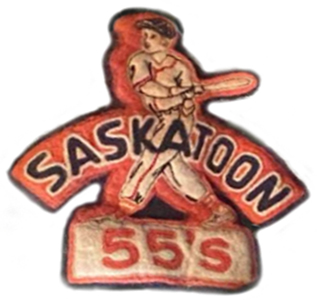 The Saskatoon Cubs and Legion teams combined to form the 55s, under new playing-manager Roy Taylor. The Gems and 55s hooked up with the North Battleford Beavers, Eston Ramblers, Prince Albert Bohemians and Colonsay Monarchs.
The Saskatoon Cubs and Legion teams combined to form the 55s, under new playing-manager Roy Taylor. The Gems and 55s hooked up with the North Battleford Beavers, Eston Ramblers, Prince Albert Bohemians and Colonsay Monarchs.
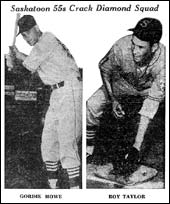 Two of the stars of the 55s of Saskatoon -- Gordie Howe and Roy Taylor.
Two of the stars of the 55s of Saskatoon -- Gordie Howe and Roy Taylor.
Howe, just beginning an illustrious NHL hockey career would later have to give up baseball on orders from the Detroit Red Wings. (Photo - Saskatoon Star Phoenix, 1951)
The three powers from the 1950 season would continue their winning, and entertaining, ways.
Edmonton would try its luck as a barnstorming team, called the Oilers.
Sceptre won six tournaments, including the Western Canada championship sponsored by the National Baseball Congress. Medicine Hat Mohawks won four tournaments including the prestigious Lacombe event.
 However, the best team on the prairies may have been Indian Head.
However, the best team on the prairies may have been Indian Head.
The Rockets walked away with the title in the Western Canada League, at one point winning 22 straight games.
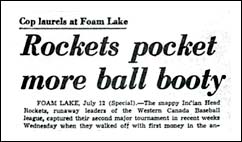 They won three tourneys, shared top prize in another, and, while beaten by Sceptre for the Western Canada title, the Rockets had triumphed in the Saskatchewan final and, in three tournaments, had whipped Sceptre in semi-final games. The Rockets didn't sit still for long. When not in league games or tournaments there was the exhibition circuit. In June, for example, the Rockets make a clean sweep of four games with clubs in the Northern loop -- Delisle, North Battleford and Saskatoon. (Headline - Regina Leader-Post, July 9, 1951)
They won three tourneys, shared top prize in another, and, while beaten by Sceptre for the Western Canada title, the Rockets had triumphed in the Saskatchewan final and, in three tournaments, had whipped Sceptre in semi-final games. The Rockets didn't sit still for long. When not in league games or tournaments there was the exhibition circuit. In June, for example, the Rockets make a clean sweep of four games with clubs in the Northern loop -- Delisle, North Battleford and Saskatoon. (Headline - Regina Leader-Post, July 9, 1951)
 Two members of the 1951 Indian Head Rockets -- Tom Alston and Bobby Prescott (left, in a 1958 photo while with Phoenix in the Pacific Coast League) advanced to the major leagues as did '51 Rocket Pumpsie Green (more below).
Two members of the 1951 Indian Head Rockets -- Tom Alston and Bobby Prescott (left, in a 1958 photo while with Phoenix in the Pacific Coast League) advanced to the major leagues as did '51 Rocket Pumpsie Green (more below).
George Mahaffy, Sceptre first baseman-pitcher, recalled in a 2001 interview how the 'ol sore arm trick helped Sceptre capture the Western semi-pro title:
" ... By the time we got there, we had gone broke and we had a local guy who was in the oil business in Edmonton come along and say I'll put thousands of dollars into your club if you'll let me put my name on the back of your uniform. We became known as the Sceptre Nixons after Red Nixon ... so Red is traveling with the team, but he hardly knew first base from third base.
Hal Price pitched against the Indian Head Rockets and beat them. Next night, we're in the finals against Indian Head … and Red Nixon comes out and says to me "Big George you're pitching this". Fergie Shields, backbone of our team … says "George, you go out and warm up and get a sore arm". So I go out and it's wet in Saskatoon, the old field on Avenue A, Cairns Field. So I just throw the hell out of the ball for five minutes and my arm's sore. So, Price is told to go as far as he can and then we'll do something else."
Price ended up going the distance against Chet Brewer to lead Sceptre to the championship.
Pete Beiden, a mainstay with the touring California Mohawks of 1949 and 1950, took over the helm in Medicine Hat after returning from an exhibition tour of Hawaii. Beiden's Fresno State team won eleven of the fourteen games. Along with Beiden came player reinforcements, Larry Bolger and Fred Bartels.
The lure of tournament cash created havoc at times. The Western League was forced to take action after clubs abandoned scheduled league dates, or tried to fill in their rosters with local players, while the "real" team was trying to win prize money in a tourney.
An 18-year-old from Colonsay was selected at a baseball camp in Regina for a tryout with the Pittsburgh Pirates. Len Breckner, a first baseman, was chosen from one hundred boys at a three-day baseball school. Breckner, a left-hander, had always batted right before he came to the school. Pirates' scout Don Lindeberg turned him into a lefty hitter.
Edmonton's Oilers would do okay in exhibition play. Early in the season the Oilers swept a three-game series from the Delisle Gems, then took three straight from the Great Falls, Montana, Airlifters. They started the season with nine straight exhibition wins. But, when it came to tournament play, the Oilers were often embarrassed.
 Swift Current found the going a little too tough and decided to amalgamate with the barnstorming Sceptre team. It caused a little confusion as players showed up at Taylor Field in Regina wearing both Sceptre and Swift Current uniforms.
Swift Current found the going a little too tough and decided to amalgamate with the barnstorming Sceptre team. It caused a little confusion as players showed up at Taylor Field in Regina wearing both Sceptre and Swift Current uniforms.
In February, Swift Current had run an ad in The Sporting News in a bid to attract some top import talent for the team.
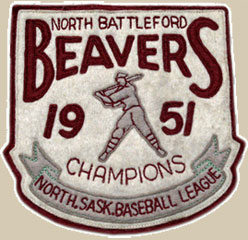 North Battleford won the Northern Saskatchewan Baseball League title.
North Battleford won the Northern Saskatchewan Baseball League title.
At the beginning of the season, the Regina Caps estimated season expenses of $27,000 (which, in 2000, would be about enough to pay an average major leaguer for about a game or two).
 The Weyburn Beavers edged the Notre Dame Hounds by a full game to win the 1951 Southern League pennant. The Beavers were also awarded the playoff championship. Although losing the only game played in the final series to the Regina Royal Caps, the Beavers were declared as playoff winners when, after a lengthy layoff due to inclement weather, the Royal Caps found themselves with a scarcity of personnel with pro hockey camps underway. Southpaw hurler Gordon Campbell (right) of the Avonlea Arrows, a first year entry in the Southern League, paced all mound performers, posting an impressive 7 - 0 record.
The Weyburn Beavers edged the Notre Dame Hounds by a full game to win the 1951 Southern League pennant. The Beavers were also awarded the playoff championship. Although losing the only game played in the final series to the Regina Royal Caps, the Beavers were declared as playoff winners when, after a lengthy layoff due to inclement weather, the Royal Caps found themselves with a scarcity of personnel with pro hockey camps underway. Southpaw hurler Gordon Campbell (right) of the Avonlea Arrows, a first year entry in the Southern League, paced all mound performers, posting an impressive 7 - 0 record.
![]() The ManDak circuit was proving highly popular. Although the Buffaloes had some early success, it would be
The ManDak circuit was proving highly popular. Although the Buffaloes had some early success, it would be  Brandon Greys taking the ManDak League championship defeating Winnipeg in four straight in the final series.
Brandon Greys taking the ManDak League championship defeating Winnipeg in four straight in the final series.
Butch Davis (right) of Winnipeg won his second straight batting crown, topping the league with a .406 average. He also won the RBI title with 53,  one more than Ian Lowe of Brandon.
one more than Ian Lowe of Brandon.
Davis, along with other stars as Leon Day, Charlie White (left) and Jim Newberry, were snatched away by pro clubs during the season. Ted "Double Duty" Radcliffe was among the dozens of former Negro League stars to join the ManDak circuit.

 Marion Sugar Cain (left), who had barnstormed in Canada and the Dakotas with the San Francisco Cubs, joined Clifton Zoonie McLean (right) a local product in Minot and the pair were among the biggest stars in the ManDak League through to the end of the circuit in 1957.
Marion Sugar Cain (left), who had barnstormed in Canada and the Dakotas with the San Francisco Cubs, joined Clifton Zoonie McLean (right) a local product in Minot and the pair were among the biggest stars in the ManDak League through to the end of the circuit in 1957.
1953 & 1954 might have been Cain's top two seasons. He finished 12-5 and 11-1 as a pitcher and hit .316 and .451. McLean played for 13 season overall, 1947 to 1959, winning the batting title in 1952 and batted over .300 nine times. His teams won league championships at least five times and was a playing manager for a half a dozens seasons.

 Jack Hannah was one of the many Fresno State collegians to suit up with clubs in Western Canada.
Jack Hannah was one of the many Fresno State collegians to suit up with clubs in Western Canada.
He did so before his college days! As a 17-year-old Visalia high schooler, Hannah pitched for Saskatoon in 1951, and for Moose Jaw the following season. After baseball there was music. Hannah is well known across the border as one of the partners in the California vocal group, Sons of the San Joaquin.
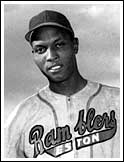 Sprinkled among the rosters were hockey stars, former Negro Leaguers (Andy Porter at left) , college kids, homegrown stars, and a couple of former major leaguers.
Sprinkled among the rosters were hockey stars, former Negro Leaguers (Andy Porter at left) , college kids, homegrown stars, and a couple of former major leaguers.
Many would move into pro ball, a few would go on to the majors, and one would be hired off the diamond to begin a football career.
Among the National Hockey League stars who turned in their skates for baseball cleats during this golden era of semi-pro baseball were Gordie Howe, Jackie McLeod, Emile Francis, Bert Olmstead, Max and Doug Bentley, Bill Gadsby, Terry Sawchuk, Vic Stasiuk, Earl Ingarfield, Hank Bassen and Gus Kyle. (See the Hockey Connection
Howe, Francis, Olmstead, the Bentleys and Gadsby would be enshrined in hockey's Hall of Fame.
Lou Pisani, a member of the barnstorming California Mohawks in 1950 and the Colonsay Monarchs in 1951, came away impressed with the baseball talents of a few of the prairies hockey stars :
" ... Gordie Howe played first base and the Bentley brothers had their own field. They were good baseball players. You know how they used to slide into a base? You know in hockey they give you a shoulder? Well, they used to come in and roll. They didn't come in with spikes high, they'd come in, slide in, and roll into you with their shoulder and knock the ball out of your glove. They played hard, they were great guys. I also remember a mean winger, Bert Olmstead. If you fooled around with him, he'd take ya out."

 Over in Manitoba, Terry Sawchuk (left) suited up with Morse Place in junior ball after three seasons in the senior league with Elmwood Giants. Sawchuk would become an NHL Hall of Famer, one of the greatest goalies in NHL history.
Over in Manitoba, Terry Sawchuk (left) suited up with Morse Place in junior ball after three seasons in the senior league with Elmwood Giants. Sawchuk would become an NHL Hall of Famer, one of the greatest goalies in NHL history.
Roland Miles (right) was the second baseman for the Regina Caps who won a tryout with the football Edmonton Eskimos and became an all-star, one of the best-ever two way players, on the gridiron.
 Dick Stone (right), of the Moose Jaw Canucks, had a cup o' coffee with the Washington Senators in 1945 and was a veteran of play in the semi-pro Global World Series.
Dick Stone (right), of the Moose Jaw Canucks, had a cup o' coffee with the Washington Senators in 1945 and was a veteran of play in the semi-pro Global World Series.
He was the ace of the Canucks staff and at one point in the 1951 season had thrown 31 consecutive shutout innings. Fans in Moose Jaw even held a Dick Stone Day.
 Among the most renown of the former Negro League stars was Chet Brewer who, in his heyday, was a match for the legendary Satchel Paige. Brewer began his Negro League career in 1925. Although in his mid 40s, Brewer would be the ace of the Sceptre tournament team and later in the season, the Indian Head Rockets. He had managed Carman of the ManDak League in 1950 and, after a season of pro ball in 1952, would return to Carman to finish out his playing days.
Among the most renown of the former Negro League stars was Chet Brewer who, in his heyday, was a match for the legendary Satchel Paige. Brewer began his Negro League career in 1925. Although in his mid 40s, Brewer would be the ace of the Sceptre tournament team and later in the season, the Indian Head Rockets. He had managed Carman of the ManDak League in 1950 and, after a season of pro ball in 1952, would return to Carman to finish out his playing days.
"Brewer was one of a stable of Kansas City Monarch pitchers that included the legendary Satchel Paige and Bullet Joe Rogan. He defeated some of the best hurlers of his day, both black and white - Willie Foster, Slim Jones, Smokey Joe Williams, Bob Feller, and Paige. He had a lively fastball and a devastating overhand "drop ball," which was especially tough on lefthanded hitters. He also threw a legal emery ball. In 1926, his first full season with the Monarchs, Brewer went 12-1 with eight complete games. His .842 winning percentage (16-3) led the league in 1929; that season, he pitched 31 consecutive scoreless innings against league competition. One of his greatest performances came under the lights in 1930 against the Homestead Grays' Smokey Joe Williams. Brewer struck out 19, including 10 in a row, only to lose 1-0 in 12 innings on a fluke hit by Chaney White. Brewer won 30 games that year. He won 16 straight games in 1934 and finished the season with 33 victories against league and non-league opponents. Pitching in Mexico in 1939, he threw two no-hitters. Brewer was a Pittsburgh Pirates scout from 1957 to 1974 and later worked for the Major League Scouting Bureau." (CBS Sportsline)
Another classic was the 1935 match up in Winnipeg when the Negro League legends hooked up in a much anticipated contest.
"Two of the greatest colored pitchers in the game staged a baseball battle for the book last night as Satchel Paige and Bismarck went nine innings to a scoreless tie with Chet Brewer and the Kansas City Monarchs in the first game of an exhibition series at renovated Osborne Stadium. Between them the starry right-handers hung up the amazing total of 30 strikeouts before Umpire Snake Siddle called a halt as twilight descended at the end of the ninth inning. Paige, displaying more smoke than Winnipeg fans have seen since Lefty Grove pitched here in the fall of 1933, took 17 victims, while the other 13 fell before Brewer's combination of speed and curves." (Winnipeg Evening Tribune, June 7, 1935)
 Indian Head first baseman Tom Alston (left) would, in 1954, be the first black player to suit up for the St. Louis Cardinals. Len Tucker, who played in Kamsack in 1952, was the first black to be signed by the Cards. Pumpsie Green (right, in 1959) of Medicine Hat and Indian Head, would finally break the colour barrier for the Boston Red Sox in 1959. John Kennedy, who suited up in the ManDak League 1950-1952 became the first to break the Phillies' colour barrier, in 1957.
Indian Head first baseman Tom Alston (left) would, in 1954, be the first black player to suit up for the St. Louis Cardinals. Len Tucker, who played in Kamsack in 1952, was the first black to be signed by the Cards. Pumpsie Green (right, in 1959) of Medicine Hat and Indian Head, would finally break the colour barrier for the Boston Red Sox in 1959. John Kennedy, who suited up in the ManDak League 1950-1952 became the first to break the Phillies' colour barrier, in 1957.
Saskatoon's Jack Hannah and Charlie Beene would be among the American imports. Both were high school players from Visalia, California.
Families were well represented. Of course, there were the Bentleys of Delisle and since the late 40s, the Dean brothers -- Les, Roy and Elton who would be key figures for the North Battleford Beavers.
Jim Olsen had one of the shortest ever tours of duty in the Western Canada League -- less than two innings. In Medicine Hat's opening game of the season, the Mohawks left fielder, a University of San Francisco product, made a nice catch on Art Worth's fly ball in the top of the 2nd inning then smashed a single in his at bat in the bottom of the 2nd frame.
"He then successfully stole second, sliding away from an attempted tag in big league style. Play started to resume, but Olsen never got up. Players rushed out to him and the PA announcer asked for a doctor. They carried Olsen off the field with both a dislocated and fractured right ankle." (Medicine Hat News, June 2, 1951)
(1951 Saskatoon 55s Program courtesy Roy Taylor, Andy Porter photo from the Saskatoon Star Phoenix via Saskatchewan Archives, June 22, 1951, 725-2)
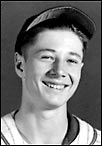 A 16-year-old left-hander from the British Columbia interior was attracting a lot of attention from baseball scouts.
A 16-year-old left-hander from the British Columbia interior was attracting a lot of attention from baseball scouts.
Ted Bowsfield would go on to pitch for seven years in the major leagues. Already he was pitching in senior/semi-pro competition in the Okanagan Mainline League and throwing shutouts and even better. Bowsfield fired a no-hitter in beating Oliver.
The following season the tossed another no-hitter, blanking Kamloops Elks. And, picked up by the Trail Smoke Eaters for a big tournament in Lethbridge, the young lefty was sensational in defeat as Trail dropped a 2-0 decision to the highly favoured Florida Cubans in the tournament final. The scouts noticed and by age 19 he was in pro ball on the way to a date in the major leagues.
In Moundsville, West Virginia a double steal got headline news. It turns out the caper happened during a game with the state penitentiary baseball team. While warming up in the bullpen, two relief pitchers made a break for a nearby woods and escaped. They were 32-year-old Rayburn Legg, serving a life sentence, and Monte Willis, 27, serving one to 15 years.
Talk about one for the record book. In Maine's amateur Casco Bay League, fans got to see not just one no-hitter, but two ! In the same game ! On Tuesday, July 3rd, Yarmouth's Dick Beote blanked the Gray nine 1-0 without surrendering a hit. Cliff Hall, the losing pitcher, also tossed a no-hitter, losing on a walk, two fielder's choices and a pair of wild pitches.

